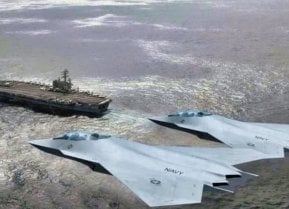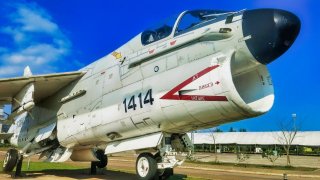Vought A-7 Corsair II: The Most Obscure U.S. Military Jet?
The Vought A-7 Corsair II may be the most obscure US military jet of the modern era; few planes have fallen through the cracks of our collective memory like the A-7.
The Vought A-7 Corsair II may be the most obscure US military jet of the modern era; few planes have fallen through the cracks of our collective memory like the A-7. Accordingly, one might be surprised to learn that the A-7 served for twenty-five years with the US Air Force and the US Navy. Still, the jet lacked the ability to transcend, or endure, culturally. Probably because the A-7 was so ugly.
Most US military jets register in some respect with the public. It’s the public after all, who pays for them. Some jets, like the SR-71 or F-22 achieve mainstream exposure through a simple cool factor. Others are featured in films, like the F-14 and F/A-18. Many are the source of contentious, bitter policy/budget debates, like the B-1, B-2, and A-10. Others play an important role in a vital historical moment, like the P-51 (World War II), F-4 (Vietnam), and B-52 (Cold War). The A-7, on the other hand, doesn’t hit any of those boxes; the A-7 simply served. And was then decommissioned. And then faded into obscurity.
The A-7 Corsair II was a subsonic light attack aircraft, capable of launching from aircraft carriers. The A-7 entered service in 1967 – and was originally slated as a replacement for the Douglas A-4 Skyhawk. Only, the Skyhawk remained in production for another 7 years, so using the A-7 as a pure replacement for the A-4 never panned out.
The A-7’s origin can be traced back to the Sea-Based Air Strike Forces (SBASF) study group. SBASF was launched to test the flight characteristics of new jet designs. The group concluded, in contrast to military aviation trends of the 1960s, that a subsonic jet would be preferable to a supersonic jet. Why? Because the subsonic jet would be smaller, cheaper, and easier to build and maintain. The SBASF’s findings were relayed into a procurement program, the VAL, or Heavier-than-air, Attack, Light.
In an effort to expedite the production process – while reducing costs – VAL required that all submissions be based on existing designs already in production. Vought submitted a design based on their F-8 Crusader – albeit with a shorter length and stubbier nose cone. Douglas, Grumman, and North American also submitted designs, but Vought’s modified F-8 won out.
Vought’s design entered flight testing in 1965, with impressive results. The new jet, which would become the A-7, was able to perform rapid aileron rolls, even with a massive, six-ton payload of bombs. Speaking of payload, the A-7 had a fantastic payload capacity – nearly double that of the A-4. The A-7 also had twice the operational range as the A-4.
Production of the A-7 kept the 35,000 workers at Vought’s Dallas plant busy; they built about one A-7 per day, every day, for several years. In total, 1,500 A-7s were built. Pilots were impressed with the aircraft, calling it easy to fly, with excellent forward visibility. Although, pilots were concerned with the A-7’s poor stability on crosswind landings, poor stopping performance on slick runways (thanks to a dysfunctional anti-skid braking system), and lackluster thrust. The lackluster thrust was later amended, when the A-7 was upgraded with the Pratt & Whitney TF30-8 engine.
In sum, pilots seemed to enjoy the A-7 – so much so that A-7 squadrons were dubbed the “A-7 Mafia”. The pilots remarked at the A-7’s payload, flexibility, bomb accuracy, reliability, and endurance. And they joked about the A-7’s aesthetics; while Vought ordained the A-7 as the “Corsair II,” the pilots referred to the A-7 as “SLUF,” or “Short Little Ugly Fucker.”
The SLUF served successfully in Vietnam, Grenada, Operation El Dorado Canyon, and the Gulf War. US forces didn’t retire the jet until 1991. The Hellenic Air Force of Greece flew the A-7 until 2014, however. Today, the only place to find the A-7 is in museums, where most patrons are there to see other jets.
About the Author
Harrison Kass is a prolific defense writer with over 1,000 articles published. An attorney, pilot, guitarist, and minor pro hockey player, he joined the US Air Force as a Pilot Trainee but was medically discharged. Harrison holds a BA from Lake Forest College, a JD from the University of Oregon, and an MA from New York University. He lives in Oregon and listens to Dokken. You can email the author: [email protected].
Image Credit: Creative Commons.


